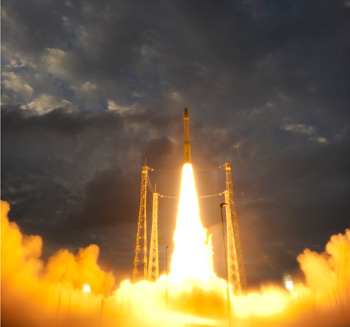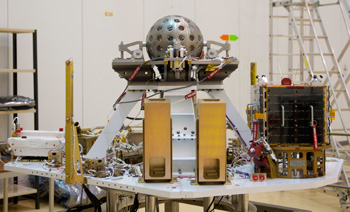ESA's Vega rocket launched a satellite in orbit that supports an experiment proposed by UT scientists in the mid-1980s.
 On February 13, 2012, the first Vega lifted off on its maiden flight from Europe's Spaceport in French Guiana carrying the LARES satellite. Credit: ESA - S. Corvaja, 2012
On February 13, 2012, the first Vega lifted off on its maiden flight from Europe's Spaceport in French Guiana carrying the LARES satellite. Credit: ESA - S. Corvaja, 2012 The LARES laser relativity satellite from Italy’s ASI space agency undergoes preparations at Europe's Spaceport in French Guiana. It was launched on board the maiden flight of the Vega. ESA Very early on the morning of Monday, February 13, the European Space Agency (ESA) launched its brand-new rocket into space, and with it went a satellite supporting an experiment that Texas physicists proposed in the mid-1980s. It also took their hopes and dreams.
The LARES laser relativity satellite from Italy’s ASI space agency undergoes preparations at Europe's Spaceport in French Guiana. It was launched on board the maiden flight of the Vega. ESA Very early on the morning of Monday, February 13, the European Space Agency (ESA) launched its brand-new rocket into space, and with it went a satellite supporting an experiment that Texas physicists proposed in the mid-1980s. It also took their hopes and dreams.“We’ve been working on this for almost 30 years,” said physicist Richard Matzner, professor of physics at The University of Texas at Austin. “With the launch, there is a note of exhaustion perhaps. But, yes, we are very happy too.”
The rocket, called Vega, has carried nine small satellites into orbit. Its principal payload was a satellite called LARES.
“LARES is a laser-ranged satellite that will be used for geophysics and studies of the earth's gravitational field,” said Matzner. “Most importantly, it will be used in a constellation of other laser-ranged satellites to validate a prediction of Einstein's description of gravity, called general relativity.”
Matzner said the LARES satellite is the outgrowth of efforts begun almost 30 years ago at the university. The lead investigator on theoretical aspects of the general relativity observations to be made by the satellite is Ignazio Ciufolini, whose Ph.D. dissertation at The University of Texas at Austin described the LARES experiment. Ciufolini was coadvised in his graduate work by Matzner and the late John Archibald Wheeler.
After his Ph.D., Ciufolini became a member of the university's Center for Space Research, and then moved to Italy, working at the University of Rome and the University of Salento, where he is now a professor. Though Ciufolini leads the LARES project, there remains a strong connection with The University of Texas at Austin. John Ries, of the Center for Space Research, and Matzner are members of the project.
The general relativity experiment is to test what’s known as “frame dragging.” The rotation of the earth slowly “drags space” with its rotation, and satellite orbits can be closely observed, via lasers, to measure the dragging.
LARES will be able to measure the effect with an accuracy that has never before been possible.
Matzner says that the satellite has already been located by ESA lasers, so it is known to be in the correct orbit. The scientists’ wait is not over, however. They will have to accumulate data for at least five years to be able to extract the science from the orbital behavior.
“But the satellite will stay in orbit for at least another 1000 years,” said Matzner, wryly. Scientists, it turns out, are used to waiting.

















Comments